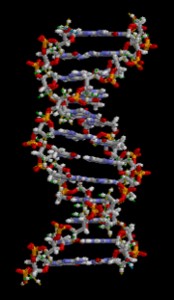29th July 2014 - New research
DISCOVERY OF NEW PARKINSON'S DISEASE GENETIC FACTORS
|
�CLICK HERE
FOR A
PRINTABLE OR WHITE BACKGROUND VERSION OF THIS ARTICLE |
Nature Genetics [2014] (27 July) (M.A.Nalls, N.Pankratz, C.M.Lill,
C.B.Do, D.G. Hernandez, M.Saad, A.L.De Stefano, E.Kara, J.Bras, M.Sharma,
C.Schulte, M.F.Keller, S.Arepalli, C.Letson, C.Edsall, H.Stefansson, X.Liu,
H.Pliner, J.H.Lee, R.Cheng, et al)
Complete abstract
������������������������������������������������������������������������������������������������������������������������������������������������������������������������������������
Six new genetic risk factors for Parkinson's Disease have been
discovered. Scientists have identified more than two dozen genetic risk
factors involved in Parkinson's Disease, including six that had not
previously been reported.
 They
conducted an extensive analysis of Parkinson's Disease genetic studies.
Twenty six sites were identified as having a significant genetic association
with Parkinson's Disease. These and six additional sites that had previously
not been reported were then tested. In total, they identified and replicated
28 independent risk variants for Parkinson's disease across 24 loci
(positions on the gene). Although the effect of each individual genetic risk
was found to be small, a risk profile analysis showed that there was a
substantial cumulative risk of developing Parkinson's Disease because of
them. The risk was actually tripled when several genetic risk factors
occurred simultaneously.
They
conducted an extensive analysis of Parkinson's Disease genetic studies.
Twenty six sites were identified as having a significant genetic association
with Parkinson's Disease. These and six additional sites that had previously
not been reported were then tested. In total, they identified and replicated
28 independent risk variants for Parkinson's disease across 24 loci
(positions on the gene). Although the effect of each individual genetic risk
was found to be small, a risk profile analysis showed that there was a
substantial cumulative risk of developing Parkinson's Disease because of
them. The risk was actually tripled when several genetic risk factors
occurred simultaneously.
Their results suggested that the more variants a person has the greater
the risk, which is up to three times higher for developing Parkinson's
Disease in some cases. Genetic causes of Parkinson's Disease usually make
Parkinson's Disease more likely rather than inevitable. Although genetic
causes of Parkinson's Disease are uncommon the actual prevalence is unknown.
In order to refer to this article on its own
click here
�
27th July 2014 - New research
NASAL DELIVERY OF PARKINSON'S DISEASE TREATMENT
|
CLICK HERE FOR A
PRINTABLE OR WHITE BACKGROUND VERSION OF THIS ARTICLE
|
Expert opinion on drug delivery [2014] 11 (6) : 827-842 (S.Md,
S.Haque, M.Fazil, M. Kumar, S.Baboota, J.K.Sahni, J.Ali)
Complete abstract
������������������������������������������������������������������������������������������������������������������������������������������������������������������������������������
Researchers evaluated whether prepared nanoparticles would be able to target
Parkinson's Disease treatments to the brain via the nasal route, thereby
enhancing their bioavailability. They tested the method using an optimised
nanoformulation of the dopamine agonist bromocriptine for direct
nose-to-brain delivery.
 The
percentage accuracy observed for intra-day and inter-day batch samples was
very high. Bromocriptine was found to be stable in all exposed conditions.
Bromocriptine nanoparticles also showed greater retention into the nostrils
for about four hours. Direct bromocriptine nanoparticle nose-to-brain
transport was shown to then bypass the blood-brain barrier. Most
importantly, bromocriptine nanoparticles administered nasally showed
significantly high dopamine concentrations.
The
percentage accuracy observed for intra-day and inter-day batch samples was
very high. Bromocriptine was found to be stable in all exposed conditions.
Bromocriptine nanoparticles also showed greater retention into the nostrils
for about four hours. Direct bromocriptine nanoparticle nose-to-brain
transport was shown to then bypass the blood-brain barrier. Most
importantly, bromocriptine nanoparticles administered nasally showed
significantly high dopamine concentrations.
The researchers concluded that Nanoparticle drug delivery system could be
potentially used as a nose-to-brain drug delivery carrier for improving the
existing means of treating Parkinson's Disease.
In order to refer to this article on its own
click here
�
23rd July 2014 - News release
APOMORPHINE CLINICAL TRIAL FOR PARKINSON'S DISEASE
Clinical trials are being undertaken of APL-130277, which is an
easy-to-administer, fast acting reformulation of the dopamine agonist
apomorphine. Apomorphine is the only approved drug for "off" episodes. As
many as half of all people with Parkinson's Disease have "off" episodes in
which they have impaired movement or speaking capabilities.
Apomorphine is normally sold as Apokyn, which is injectable. For more
information go to
Apokyn However, 85% of Apokyn patients
have an injection site reaction due to apomorphine's acidity and so must
continuously change the injection site. APL-130277 contains a buffer that
protects the patient from the acidic properties of Apokyn.
 CTH-105
is a Phase 2 clinical study of APL-130277. APL-130277 will be studied in 16
people with Parkinson's disease who have not used apomorphine and who
experience at least one daily "off" episode, with a total duration of "off"
in any 24-hour period of at least 2 hours. This open study will examine the
effect of APL-130277 on relieving "off" episodes over a single day, with
dose-titration used to determine dose strengths necessary for future
clinical use.
CTH-105
is a Phase 2 clinical study of APL-130277. APL-130277 will be studied in 16
people with Parkinson's disease who have not used apomorphine and who
experience at least one daily "off" episode, with a total duration of "off"
in any 24-hour period of at least 2 hours. This open study will examine the
effect of APL-130277 on relieving "off" episodes over a single day, with
dose-titration used to determine dose strengths necessary for future
clinical use.
In particular, the dose strength information is necessary in order to
conduct the larger CTH-300a efficacy study in apomorphine naive patients,
which is expected to commence at the end of 2014. The primary means of
assessment will be the change in the UPDRS III score, which is the most
widely used Parkinson's Disease symptom questionnaire. For more information
go to
Cynapsus�
In order to refer to this article on its own
click here
|
FOR A
PRINTABLE OR WHITE BACKGROUND VERSION OF THIS ARTICLE
CLICK HERE |
17th July 2014 - New research
SOCIAL PHOBIAS ARE COMMON IN PARKINSON'S DISEASE
Neuropsychiatric
Disease and Treatment [2014] 10 : 829-834 (B.K.Gultekin, B.Ozdilek, E.E.
Bestepe)
Complete abstract
Researchers aimed to investigate the frequency of social phobias in
people with Parkinson's Disease. They also explored the relationship between
social phobia and the characteristics of Parkinson's Disease, and the
frequency of other psychiatric disorders in Parkinson's Disease.
 Social
phobia (Social anxiety disorder) is a persistent fear about social
situations and being around people. Much more than just shyness it can
causes intense, overwhelming fear over what may just be an everyday activity
like shopping or speaking on the phone. People affected by it may fear doing
or saying something they think will be humiliating. For more information go
to
Social Phobias Social phobia was
diagnosed in 42% of people with Parkinson's Disease. Of those, 58% also had
depression, 53% also had anxiety, and 17% also had panic disorders. Social phobia was more frequent in : males, early-onset
Parkinson's Disease, people with a long duration of Parkinson's Disease, the
presence of postural instability, and with the use of a high L-dopa intakes.
Social
phobia (Social anxiety disorder) is a persistent fear about social
situations and being around people. Much more than just shyness it can
causes intense, overwhelming fear over what may just be an everyday activity
like shopping or speaking on the phone. People affected by it may fear doing
or saying something they think will be humiliating. For more information go
to
Social Phobias Social phobia was
diagnosed in 42% of people with Parkinson's Disease. Of those, 58% also had
depression, 53% also had anxiety, and 17% also had panic disorders. Social phobia was more frequent in : males, early-onset
Parkinson's Disease, people with a long duration of Parkinson's Disease, the
presence of postural instability, and with the use of a high L-dopa intakes.
Social phobia is frequently observed in Parkinson's Disease. Therefore,
the researchers suggest that the assessment of people with Parkinson's
Disease patients should always include psychiatric evaluations, particularly
for social phobia.� In order to refer to this article on its own
click here
|
FOR A
PRINTABLE OR WHITE BACKGROUND VERSION OF THIS ARTICLE
CLICK HERE |
�
14th July 2014 - New research
FREQUENT
MISDIAGNOSIS OF PARKINSON'S DISEASE
Neurology [2014] Jun 27[Epub ahead of print] (C.H.Adler, T.G.Beach,
J.G.Hentz, H.A.Shill, J.N.Caviness, E.Driver-Dunckley, M.N.Sabbagh, L.I.Sue,
S.A.Jacobson, C.M.Belden, B.N. Dugger)�
Complete abstract
Researchers aimed to determine the diagnostic accuracy of a clinical
diagnosis of Parkinson's Disease using neuropathologic diagnosis as the
standard. The accuracy of diagnosis was found to be very poor.
Data
were used to determine the predictive value of a clinical Parkinson's
Disease diagnosis, using two clinical diagnostic confidence levels : PossPD
(never treated or not clearly responsive) and ProbPD (responsive to
medications).
 Using
neuropathologic findings of Parkinson's Disease as the standard, this study
established a finding of only 26% accuracy for a clinical diagnosis of
Parkinson's Disease in untreated patients, 53% accuracy in early Parkinson's
Disease of less than five years duration that was responsive to medication,
and 85% diagnostic accuracy in Parkinson's Disease of longer duration that
was medication-responsive. Clinical variables that improved diagnostic
accuracy were medication response, motor fluctuations, dyskinesias, and
hyposmia (reduced sense of smell).ic accuracy in Parkinson's Disease of
longer duration that was medication-responsive.
Using
neuropathologic findings of Parkinson's Disease as the standard, this study
established a finding of only 26% accuracy for a clinical diagnosis of
Parkinson's Disease in untreated patients, 53% accuracy in early Parkinson's
Disease of less than five years duration that was responsive to medication,
and 85% diagnostic accuracy in Parkinson's Disease of longer duration that
was medication-responsive. Clinical variables that improved diagnostic
accuracy were medication response, motor fluctuations, dyskinesias, and
hyposmia (reduced sense of smell).ic accuracy in Parkinson's Disease of
longer duration that was medication-responsive.
This study showed that
a clinical diagnosis of Parkinson's Disease identifies people who will have
pathologically confirmed Parkinson's Disease with a sensitivity of 88% and
specificity of 68%.
For more information concerning the diagnosis of Parkinson's Disease go to
Diagnosis of Parkinson's Disease
In order to refer to this article on its own
click here
|
FOR A
PRINTABLE OR WHITE BACKGROUND VERSION OF THIS ARTICLE
CLICK HERE |
�
10th July 2014 - New research
�-ASARONE INCREASES L-DOPA IN PARKINSON'S DISEASE
Clinical and Experimental Pharmacology and Physiology [2014] Jun 7 [Epub
ahead of print] (L.Huang, M.Deng, S.Zhang, Y.Fang, L.Li)�
Complete abstract
In order to increase the effect of L-dopa it is usually administered in
combination with a dopa decarboxylase inhibitor. In Sinemet, L-dopa is
combined with carbidopa. In Madopar, L-dopa is combined with benserazide.
The co-administration of �-asarone and Levodopa is being developed as a
means of improving the effect of L-dopa even further.
 �-asarone
is found in the flowering plant acorus and also in asarum, which is known as
wild ginger. For more information go to
Ansarone
�-asarone
is found in the flowering plant acorus and also in asarum, which is known as
wild ginger. For more information go to
Ansarone
In animal studies the use of L-dopa in combination with �-asarone was
compared to the use of existing methods of treating Parkinson's Disease.
Dopamine levels were found to increase in the brain (in the striatum) and in
blood plasma in response to �-asarone. The co-administration of �-asarone
and L-dopa could also increase the levels in blood plasma of tyrosine
hydroxylase, which is the enzyme responsible for the formation of L-dopa.
Altogether, �-asarone was found to have an effect on converting L-dopa into
dopamine by modulating the activity of dopamine metabolism.
The mechanism of co-administration of �-asarone and L-dopa is different from
that of Sinemet and Madopar in the treatment of Parkinson's Disease. The
co-administration of �-asarone and L-dopa may be more beneficial to
Parkinson's Disease treatment than the existing methods and so could
eventually replace them.� In order to refer to this article on its own
click here
|
FOR A
PRINTABLE OR WHITE BACKGROUND VERSION OF THIS ARTICLE
CLICK HERE |
�
5th July 2014 - New research
THE WORLDWIDE PREVALENCE OF PARKINSON'S DISEASE
Movement Disorders [2014] Jun 28 [Epub ahead of print] (T.Pringsheim,
N.Jette, A.Frolkis, T.D.Steeves)
�
Complete abstract
Researchers sought to synthesize studies on the prevalence of Parkinson's
Disease to obtain an overall view of how the prevalence varies by age,
gender, and geographic location. Geographic location was stratified by the
following groups : Asia, Africa, South America, Europe / North America /
Australia. Data were analyzed by age group, geographic location, and gender.
 Analysis
of worldwide data showed a rising prevalence of Parkinson's Disease with
age, with (per 100,000) : 41 in 40 to 49 year olds, 107 in 50 to 59 year
olds, 173 in 55 to 64 year olds, 428 in 60 to 69 year olds, 1087 in 70 to 79
year olds, and 1903 in those aged older than 80.A
significant difference was seen in prevalence geographically only for people
who were 70 to 79 years old, with a prevalence of 1601 (per 100,000) in
people in North America, Europe, and Australia, compared to only 646 (per
100,000) in people from Asia. Differences in prevalence according to gender
was found only for people who were 50 to 59 years old, with a prevalence of
41 in females and 134 in males.
Analysis
of worldwide data showed a rising prevalence of Parkinson's Disease with
age, with (per 100,000) : 41 in 40 to 49 year olds, 107 in 50 to 59 year
olds, 173 in 55 to 64 year olds, 428 in 60 to 69 year olds, 1087 in 70 to 79
year olds, and 1903 in those aged older than 80.A
significant difference was seen in prevalence geographically only for people
who were 70 to 79 years old, with a prevalence of 1601 (per 100,000) in
people in North America, Europe, and Australia, compared to only 646 (per
100,000) in people from Asia. Differences in prevalence according to gender
was found only for people who were 50 to 59 years old, with a prevalence of
41 in females and 134 in males.
Parkinson's Disease
prevalence worldwide increases steadily with age. Some differences in
prevalence according to geographic location and gender can be detected.
For more information concerning the prevalence of Parkinson's Disease go to
the
Prevalence of Parkinson's Disease
�In order to refer to this article on its own
click here
|
FOR A
PRINTABLE OR WHITE BACKGROUND VERSION OF THIS ARTICLE
CLICK HERE |
�
.gif)
.gif)
 They
conducted an extensive analysis of Parkinson's Disease genetic studies.
Twenty six sites were identified as having a significant genetic association
with Parkinson's Disease. These and six additional sites that had previously
not been reported were then tested. In total, they identified and replicated
28 independent risk variants for Parkinson's disease across 24 loci
(positions on the gene). Although the effect of each individual genetic risk
was found to be small, a risk profile analysis showed that there was a
substantial cumulative risk of developing Parkinson's Disease because of
them. The risk was actually tripled when several genetic risk factors
occurred simultaneously.
They
conducted an extensive analysis of Parkinson's Disease genetic studies.
Twenty six sites were identified as having a significant genetic association
with Parkinson's Disease. These and six additional sites that had previously
not been reported were then tested. In total, they identified and replicated
28 independent risk variants for Parkinson's disease across 24 loci
(positions on the gene). Although the effect of each individual genetic risk
was found to be small, a risk profile analysis showed that there was a
substantial cumulative risk of developing Parkinson's Disease because of
them. The risk was actually tripled when several genetic risk factors
occurred simultaneously.  The
percentage accuracy observed for intra-day and inter-day batch samples was
very high. Bromocriptine was found to be stable in all exposed conditions.
Bromocriptine nanoparticles also showed greater retention into the nostrils
for about four hours. Direct bromocriptine nanoparticle nose-to-brain
transport was shown to then bypass the blood-brain barrier. Most
importantly, bromocriptine nanoparticles administered nasally showed
significantly high dopamine concentrations.
The
percentage accuracy observed for intra-day and inter-day batch samples was
very high. Bromocriptine was found to be stable in all exposed conditions.
Bromocriptine nanoparticles also showed greater retention into the nostrils
for about four hours. Direct bromocriptine nanoparticle nose-to-brain
transport was shown to then bypass the blood-brain barrier. Most
importantly, bromocriptine nanoparticles administered nasally showed
significantly high dopamine concentrations. 
 Social
phobia (Social anxiety disorder) is a persistent fear about social
situations and being around people. Much more than just shyness it can
causes intense, overwhelming fear over what may just be an everyday activity
like shopping or speaking on the phone. People affected by it may fear doing
or saying something they think will be humiliating. For more information go
to
Social
phobia (Social anxiety disorder) is a persistent fear about social
situations and being around people. Much more than just shyness it can
causes intense, overwhelming fear over what may just be an everyday activity
like shopping or speaking on the phone. People affected by it may fear doing
or saying something they think will be humiliating. For more information go
to
 Using
neuropathologic findings of Parkinson's Disease as the standard, this study
established a finding of only 26% accuracy for a clinical diagnosis of
Parkinson's Disease in untreated patients, 53% accuracy in early Parkinson's
Disease of less than five years duration that was responsive to medication,
and 85% diagnostic accuracy in Parkinson's Disease of longer duration that
was medication-responsive. Clinical variables that improved diagnostic
accuracy were medication response, motor fluctuations, dyskinesias, and
hyposmia (reduced sense of smell).ic accuracy in Parkinson's Disease of
longer duration that was medication-responsive.
Using
neuropathologic findings of Parkinson's Disease as the standard, this study
established a finding of only 26% accuracy for a clinical diagnosis of
Parkinson's Disease in untreated patients, 53% accuracy in early Parkinson's
Disease of less than five years duration that was responsive to medication,
and 85% diagnostic accuracy in Parkinson's Disease of longer duration that
was medication-responsive. Clinical variables that improved diagnostic
accuracy were medication response, motor fluctuations, dyskinesias, and
hyposmia (reduced sense of smell).ic accuracy in Parkinson's Disease of
longer duration that was medication-responsive.  �-asarone
is found in the flowering plant acorus and also in asarum, which is known as
wild ginger. For more information go to
�-asarone
is found in the flowering plant acorus and also in asarum, which is known as
wild ginger. For more information go to 